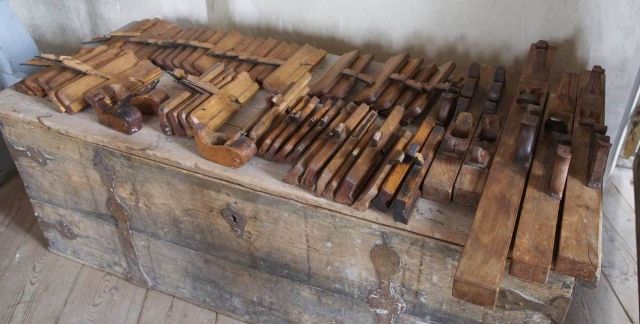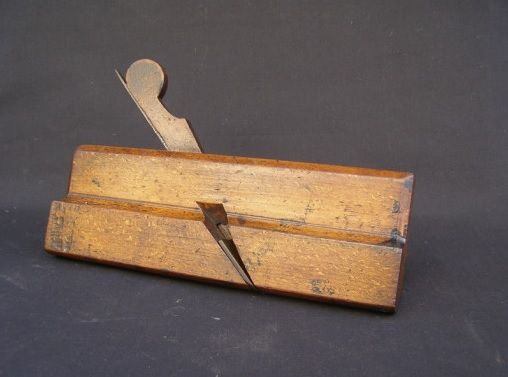Corneel
Established Member
In the last "Gildebrief" from the Dutch antique tool club Ambacht en Gereedschap http://www.ambachtengereedschap.nl/ was a very interesting article about the earliest Dutch moulding planes found in the Skokloster castle in Sweden. The article is written by Hein Coolen, one of the owners of Ducotools http://www.ducotools.dds.nl/wordpress/ and president of the club.
I am not going to copy or translate the article, because I am not mr. Coolen. But I am sure there are some people overhere interested in his ideas, and because a Dutch article isn't very accessible, I write this short introduction to his theory.
The pictures below are from several Internet blogs:
https://hyvelbenk.wordpress.com/2015/04/25/tools-from-skokloster-castle-in-sweden/
https://pfollansbee.wordpress.com/2016/09/12/heres-why-i-went-to-stockholm/
http://oldwoodplanes.co.uk/moulding-planes-updated-02-11-14/
The incredibly rich General Wrangel had a castel build in Sweden in the 17th century. He ordered all kinds of toys from all over Europe. One of his hobbies was woodturning, like many aristocrats back then, so he ordered a huge amount of tools from Amsterdam. Among the loot were also 64 woodworking planes, delivered in 1664. Here is wat is left of that collection.

As you might know (or not) the oldest know Dutch professional planemaker is Michel Corneliszn born 1581 in Antwerp, who moved to Amsterdam in 1585 and started his shop around 1600. The oldest known English planemaker is Thomas Granford. From 1654 onwards there were three generations and the second generation (1687-1716) seems to be the one who made a lot of planes professionally. With the Dutch being at least half a century earlier then the English there has always been the question if and how much the English were influenced by the Dutch, but because the Dutch planes look quite different, very "baroque" compared to the more puritan English shapes, a link between the two is not immediately obvious.
And then, a thourough examination of the Skokloster planes brought to light the existance of intermediate shapes which make a link between the Dutch and the later English moulding planes much more logical.
About half of the Skokloster moulding planes look a lot more like the later English ones. They don't have the carved details of the later Dutch planes.

Compare this to a typical early English plane, this one from John Partridge

There are a lot of similarities. The chamfers, the gouge cuts terminating the chamfers, the down sloping shoulder. The length of the plane, Dutch planes were never very uniform in length while the English later standardised on 9 1/2", these planes are about 10 1/2". The Dutch complex moulding planes never used a spring angle, and the earliest English ones didn't either.
Differences between the two are the shape of the escapement and the shape of the wedge.
Interesting is also that the carved Skokloster moulding planes haven't reached their later uniform shape quite yet either. This also indicates that this is a transition period in Dutch planemaking.
This theory of Hein Coolen is very attractive. Of course we will never know for sure, unless someone finds a diary of a Dutch planemaker who moved to Londen and teached Thomas Granford, or something like that.
I am not going to copy or translate the article, because I am not mr. Coolen. But I am sure there are some people overhere interested in his ideas, and because a Dutch article isn't very accessible, I write this short introduction to his theory.
The pictures below are from several Internet blogs:
https://hyvelbenk.wordpress.com/2015/04/25/tools-from-skokloster-castle-in-sweden/
https://pfollansbee.wordpress.com/2016/09/12/heres-why-i-went-to-stockholm/
http://oldwoodplanes.co.uk/moulding-planes-updated-02-11-14/
The incredibly rich General Wrangel had a castel build in Sweden in the 17th century. He ordered all kinds of toys from all over Europe. One of his hobbies was woodturning, like many aristocrats back then, so he ordered a huge amount of tools from Amsterdam. Among the loot were also 64 woodworking planes, delivered in 1664. Here is wat is left of that collection.

As you might know (or not) the oldest know Dutch professional planemaker is Michel Corneliszn born 1581 in Antwerp, who moved to Amsterdam in 1585 and started his shop around 1600. The oldest known English planemaker is Thomas Granford. From 1654 onwards there were three generations and the second generation (1687-1716) seems to be the one who made a lot of planes professionally. With the Dutch being at least half a century earlier then the English there has always been the question if and how much the English were influenced by the Dutch, but because the Dutch planes look quite different, very "baroque" compared to the more puritan English shapes, a link between the two is not immediately obvious.
And then, a thourough examination of the Skokloster planes brought to light the existance of intermediate shapes which make a link between the Dutch and the later English moulding planes much more logical.
About half of the Skokloster moulding planes look a lot more like the later English ones. They don't have the carved details of the later Dutch planes.

Compare this to a typical early English plane, this one from John Partridge

There are a lot of similarities. The chamfers, the gouge cuts terminating the chamfers, the down sloping shoulder. The length of the plane, Dutch planes were never very uniform in length while the English later standardised on 9 1/2", these planes are about 10 1/2". The Dutch complex moulding planes never used a spring angle, and the earliest English ones didn't either.
Differences between the two are the shape of the escapement and the shape of the wedge.
Interesting is also that the carved Skokloster moulding planes haven't reached their later uniform shape quite yet either. This also indicates that this is a transition period in Dutch planemaking.
This theory of Hein Coolen is very attractive. Of course we will never know for sure, unless someone finds a diary of a Dutch planemaker who moved to Londen and teached Thomas Granford, or something like that.





































